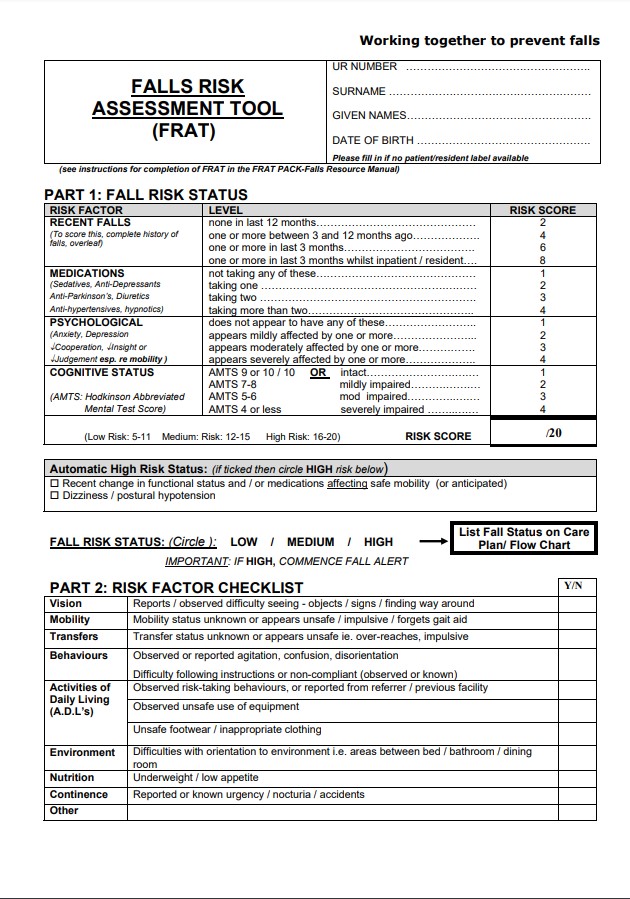Some Known Details About Dementia Fall Risk
Dementia Fall Risk Things To Know Before You Get This
Table of ContentsLittle Known Questions About Dementia Fall Risk.Not known Facts About Dementia Fall RiskDementia Fall Risk - TruthsFascination About Dementia Fall Risk
A loss danger evaluation checks to see exactly how most likely it is that you will fall. It is mostly provided for older grownups. The evaluation normally includes: This consists of a series of inquiries concerning your general wellness and if you have actually had previous falls or problems with equilibrium, standing, and/or walking. These tools examine your strength, equilibrium, and gait (the way you stroll).STEADI includes testing, analyzing, and treatment. Interventions are suggestions that may lower your danger of dropping. STEADI includes 3 steps: you for your threat of succumbing to your threat factors that can be boosted to attempt to stop falls (for instance, balance troubles, impaired vision) to lower your danger of dropping by using reliable strategies (for instance, giving education and resources), you may be asked numerous questions including: Have you dropped in the previous year? Do you feel unsteady when standing or walking? Are you fretted about dropping?, your company will certainly evaluate your stamina, balance, and gait, making use of the following autumn assessment tools: This test checks your stride.
Then you'll sit down once again. Your copyright will inspect how much time it takes you to do this. If it takes you 12 secs or even more, it might imply you are at higher threat for an autumn. This examination checks toughness and balance. You'll sit in a chair with your arms went across over your upper body.
Relocate one foot halfway forward, so the instep is touching the big toe of your various other foot. Move one foot totally in front of the various other, so the toes are touching the heel of your other foot.
The Ultimate Guide To Dementia Fall Risk
Many drops occur as an outcome of numerous adding variables; consequently, handling the risk of dropping begins with identifying the factors that contribute to fall risk - Dementia Fall Risk. Some of the most relevant risk elements consist of: History of prior fallsChronic clinical conditionsAcute illnessImpaired stride and equilibrium, lower extremity weaknessCognitive impairmentChanges in visionCertain risky drugs and polypharmacyEnvironmental elements can likewise enhance the danger for falls, including: Insufficient lightingUneven or damaged flooringWet or slippery floorsMissing or harmed hand rails and get hold of barsDamaged or poorly equipped tools, such as beds, wheelchairs, or walkersImproper use assistive devicesInadequate supervision of the people staying in the NF, including those that exhibit aggressive behaviorsA effective fall risk management program needs a detailed scientific assessment, with input from all members of the interdisciplinary team

The treatment strategy must likewise include interventions that are system-based, such as those that promote a risk-free atmosphere (proper illumination, hand rails, get hold of bars, and so on). The effectiveness of the treatments need to be assessed occasionally, and the treatment plan revised click for more as necessary to reflect adjustments in the loss threat assessment. Executing a fall threat administration system utilizing evidence-based ideal practice can minimize the occurrence of falls in the NF, while limiting the possibility for fall-related injuries.
How Dementia Fall Risk can Save You Time, Stress, and Money.
The AGS/BGS standard recommends evaluating all grownups matured 65 years and older for loss danger annually. This screening consists of asking patients whether they have fallen 2 or even more times in the past year or sought medical attention for a loss, or, if they have actually not dropped, whether they feel unsteady when strolling.
Individuals that have actually dropped when without injury ought to have their balance and gait assessed; those with stride or balance abnormalities need to get additional assessment. A background of 1 loss without injury and without stride or equilibrium issues does not warrant more evaluation past continued yearly fall risk testing. Dementia Fall Risk. An autumn danger analysis is required as part of the Welcome to Medicare evaluation

Little Known Questions About Dementia Fall Risk.
Documenting a falls history is one of the quality indicators for fall prevention and management. A vital part of danger analysis is a medicine evaluation. Several classes of medications increase fall threat (Table 2). Psychoactive medications in specific are independent forecasters of falls. These medications often tend to be sedating, modify the sensorium, and harm equilibrium and stride.
Postural hypotension can usually be alleviated by reducing the dose of blood pressurelowering medications and/or quiting medicines that have orthostatic hypotension as an adverse effects. Usage of above-the-knee support pipe and sleeping with the head of the bed elevated may likewise decrease postural decreases in blood pressure. The advisable aspects of a fall-focused physical exam are go to my blog displayed in Box 1.
-copy-5.jpg)
A TUG time better than or equivalent to 12 seconds suggests high loss threat. Being unable to stand up from a chair of knee height you could check here without using one's arms suggests raised fall risk.